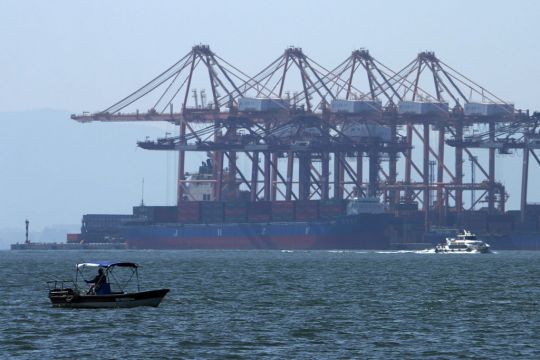The United Nations has issued a sombre global economic forecast for 2024, pointing to challenges from escalating conflicts, sluggish global trade, persistently high interest rates and increasing climate disasters.
In its flagship economic report, the UN projected that global economic growth would slow to 2.4% this year from an estimated 2.7% in 2023, which exceeds expectations.
But both are still below the 3% growth rate seen before the Covid-19 pandemic began in 2020, it said.
The UN forecast is lower than those of the International Monetary Fund (IMF) in October and the Organisation for Economic Cooperation and Development (OECD) in late November.
Global economic growth is projected to slow from 2.7% in 2023 to 2.4% in 2024, trending below the pre-pandemic level of 3%.
Details in @UNDESA's new #WorldEconomyReport: https://t.co/ZIGqyHM2jG pic.twitter.com/WcxX254xucAdvertisement— United Nations (@UN) January 4, 2024
The IMF said it expects global growth to slow from an expected 3% in 2023 to 2.9% in 2024.
The Paris-based OECD, comprising 38 mainly developed countries, estimated that international growth would also slow from an expected 2.9% in 2023 to 2.7% in 2024.
The UN’s report – World Economic Situation and Prospects 2024 – warned that the prospects of prolonged tighter credit conditions and higher borrowing costs present “strong headwinds” for a world economy saddled with debt, especially in poorer developing countries, and needing investment to resuscitate growth.
Shantanu Mukherjee, director of the UN’s Economic Analysis and Policy Division, said fears of a recession in 2023 were averted mainly due to the United States, the world’s largest economy, curbing high inflation without putting the brakes on the economy.
But he told a news conference launching the report: “We’re still not out of the danger zone.”
Mr Mukherjee said that is because the unsettled situation in the world could fuel inflation.

For example, another supply chain shock or problem in fuel availability or distribution could prompt another interest rate hike to bring the situation under control, he said.
“We’re not expecting a recession, per se, but because there is volatility in the environment around us, this is the major source of risk,” he added.
Very high interest rates for a long time and the threat of possible shocks to prices contribute to “quite a difficult balancing act”, Mr Mukherjee said.
“So that’s really why we said that we are not yet out of the woods.”
According to the report, global inflation, which was at 8.1% in 2022, is estimated to have declined to 5.7% in 2023, and is projected to decline further to 3.9% in 2023.
But in about a quarter of all developing countries, annual inflation is projected to exceed 10% this year, it said.
While the US economy performed “remarkably well” in 2023, the report said growth is expected to decline from an estimated 2.5% in 2023 to 1.4% this year.

“Amid falling household savings, high interest rates, and a gradually softening labour market, consumer spending is expected to weaken in 2024 and investment is projected to remain sluggish,” the UN said.
“While the likelihood of a hard landing has declined considerably, the United States economy will face significant downside risks from deteriorating labour, housing and financial markets.”
With elevated inflation and high interest rates, the report said Europe faces “a challenging economic outlook”.
GDP in the European Union is forecast to expand from 0.5% in 2023 to 1.2% in 2024, it said, with the increase driven by “a pick-up in consumer spending as price pressures ease, real wages rise, and labour markets remain robust”.
Japan, the world’s fourth-largest economy, is projected to see economic growth slow from 1.7% in 2023 to 1.2% this year despite the country’s monetary and fiscal policies, the report said.
“Rising inflation may signal an end from the deflationary trend that persisted for more than two decades” in the country, it added.
The 75 countries eligible to borrow from @WBG_IDA, which supports the world’s poorest countries, paid a record $88.9 billion in debt-servicing costs in 2022.
Details in the latest #IntlDebtReport: https://t.co/I23zbrAqmY pic.twitter.com/X8JEMH5jx5— World Bank (@WorldBank) January 4, 2024
In China, the world’s second-largest economy, the UN said recovery from Covid lockdowns has been more gradual than expected “amid domestic and international headwinds”.
With economic growth of just 3.0% in 2022, the report said China turned a corner during the second half of 2023 with the growth rate reaching 5.3%. But it said the combination of a weak property sector and faltering external demand for its products “will nudge growth down moderately to 4.7% in 2024”.
In developing regions, the UN said economic growth in Africa is projected to remain weak with a slight increase from an average of 3.3% in 2023 to 3.5% in 2024.
“The unfolding climate crisis and extreme weather events will undermine agricultural output and tourism, while geopolitical instability will continue to adversely impact several subregions … especially the Sahel and North Africa,” the report said.
The UN forecasts a moderate slowdown in East Asia economies from 4.9% in 2023 to 4.6% in 2024. In Western Asia, GDP is forecast to grow by 2.9% in 2024, up from 1.7% in 2023.
In South Asia, GDP rose by an estimated 5.3% last year and is projected to increase by 5.2% in 2024, “driven by a robust expansion in India, which remains the fastest growing large economy in the world”.
Its growth is forecast to reach 6.2% this year, similar to its projected 6.3% increase in 2023.







